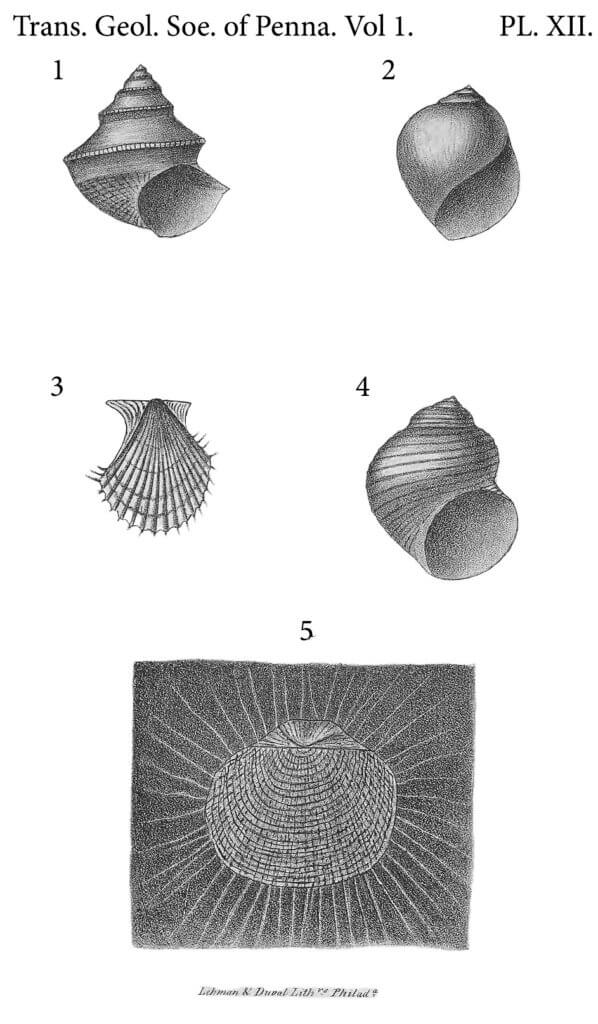The following is a republication of the work by T.A. Conrad. The original was published in 1835 and features three gastropods known today as Worthenia tabulatus, Strobeus primogenius, and Shansiella carbonaria (as Turbo insectus). Shansiella is known but not confirmed, with authors accepting a specimen authored by Norwood and Pratten in 1855. The illustration below was unknown and later not precise enough to correlate. We dive deep into that story in The Curious Case of the nomem dubium Turbo insectus.
Author: T.A. Conrad
Publication: Transactions of the Geological Society of Pennsylvania
Year: 1835
DOI: https://doi.org/10.5962/bhl.title.83715
Print Version: https://www.biodiversitylibrary.org/page/45593515
Stylifer, Sow.
S. primogenia. PI.12, fig. 2. Shell ventricose, volutions rounded; suture well defined; aperture more than half the length of the shell; margin of the labium arcuated.
It is with some doubt that I refer this shell to the genus Stylifer of Sowerby, which has been founded on recent species alone; but it strongly resembles S. astericola, Sow., except that is much larger; it has however some of the characters of Paludina, and may possibly have been a fresh water shell.
It varies much in outline, as the figures will show. Occurs in slate, and the shell replaced by crystallized carbonate of lime.
Turbo, Lam.
- T. tabulatus. PI. 12, fig. 1. Shell turrited; whirls of the spire each with a carinated crenulated line, and numerous spiral wrinkled raised lines; body whirl concave above, with fine revolving lines; beneath sub-cancellated, and with distant revolving tuberculated lines, more numerous at base.
- T. insectus. Pl. 12, fig. 4. Shell turbinate, ventricose, with prominent coarse revolving stria; whirls convex, flattened above; aperture orbicular, about half the length of the shell.
Found with the preceding fossils, and resembling them in mineral composition.
Productus, Sow.
P. confragosus. PI. 12, fig. 5. Shell suboval, larger valve with a longitudinal sulcus; valves with numerous rugose concentric lines, and long filiform spines.
In slate, stratum K of Mr Miller’s section; the shell has been replaced by pyrites.
Numbers are in a specimen of slate, all very much distorted by pressure; the perfection of the filiform spines is remarkable. In the cabinet of Richard C. Taylor, Esq., are European specimens of two species, which evidently possessed spines similar to those of the confragosus, as fragments of the spines clearly exhibit; and many other species were doubtless armed in a similar manner. On one specimen of the slate, a fern is associated with numbers of the present species of productus. *
Pecten.
P. armigerus. PI. 12, fig. 3. Shell ovate, with angular costa, and slender, erect, very prominent spines; ears unequal; one ear of the left valve elongated and pointed.
In slate; the interior of the left valve is the only specimen I have seen, but it is remarkably perfect and dis-tinct.
The following fossils accompanied the shells here described:
- Productus scoticus, Sow.
- Productus sulcatus, Sow.
- Unio, allied to U. subconstrictus, Sow.
- Spirifer undulatus, Sow.
- Cyathophyllum ceratites, Gold.
- Calamopora poly morpha, Gold.
- Cyathocrinites pinnatus, Gold.
- Orthocera, undetermined.
- Nautilus, undetermined.
As a considerable number of fossils are common to the granwacke in Europe and America, it is very desirable that an accurate list of such species should be published to assist the geological inquirer. From the tables of De la Beche I have at present merely enumerated such organic remains, adding a few which I have myself identified.
*The European specimens of Producta, with spines, I collected from the dark limestone shale of Berwick upon Tweed, and from a similar shale at Abersychan Iron Works, Monmouthshire. R. C. T.

